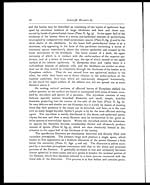Medicine - Institutions > Army health reports and medical documents > Scientific memoirs by medical officers of the Army of India > Part III, 1887 > 3 - On a new genus of the family Ustilaginae
(33) [Page 27]
Download files
Individual page:
Thumbnail gallery: Grid view | List view
![(1) [Page 27] -](https://deriv.nls.uk/dcn17/7500/75004101.17.jpg)
On a new Genus of the Family Ustilagineæ.
BY
SURGEON-MAJOR D. D. CUNNINGHAM, M.B.,
SPECIAL ASSISTANT TO THE SANITARY COMMISSIONER WITH THE GOVERNMENT OF INDIA.
(With Plates I and II.)
The parasite forming the subject of the present paper was first observed in
the autumn of 1886 in the Botanical Garden in Calcutta. It occurred in the leaves
of Nymphœa stellata, Nymphœa lotus, and Nymphœa rubra, which, although
regarded as a mere variety by systematists, are unequivocally, so far as physiolo-
gical characters go, distinct species. It does not appear to occur either in Euryale
or Nelumbium. Whilst affecting the three Nymphœas above mentioned, it is very
much more abundant in Nymphœa stellata than in the others, and I shall there-
fore describe it in detail as occurring in that species, merely referring to any
points of variation which seem to present themselves when it affects the other
hosts.
In Nymphœa stellata it affects leaves of all ages, appearing even in quite
young ones. The first indication of its presence is the appearance of small,
circumscribed, bright yellow spots on the upper surfaces of the leaves
(Plate I, fig. 3). These spots usually occur associated in large numbers, but
occasionally perfectly isolated ones appear on otherwise healthy leaves. In
some cases they are evenly sprinkled over the entire surface, but in most cases they
tend to occur in patches or lines over limited areas of the leaf. Where very
closely set they often become confluent at the margins over comparatively large
areas. When they first appear, the alteration in the tissues of the host does not
extend to the under-surface of the leaf, which retains its beautiful deep violet
colour unaltered. After a time the centres of the yellow spots become brown and
ultimately almost black in many instances. As this change goes on, the patches
begin to appear on the lower surface as deep blue spots, which soon become
greenish centrally, and eventually decay sets in and leads to the formation
of perforations surrounded on the upper surface by yellow zones of tissue
containing the parasite.
Before proceeding to describe the characters of the parasite it is necessary
to give some account of the structure of the leaves of the host-plant. This is very
peculiar in Nymphœa stellata, and is quite distinct from that in either of the
other two species. There is an entire absence of any stratum of palisade cells,
E 2
Set display mode to: Large image | Zoom image | Transcription
Images and transcriptions on this page, including medium image downloads, may be used under the Creative Commons Attribution 4.0 International Licence unless otherwise stated. ![]()
| Permanent URL | https://digital.nls.uk/75004099 |
|---|
| Shelfmark | IP/QB.10 |
|---|---|
| Additional NLS resources: | |



![[Page 26]](https://deriv.nls.uk/dcn4/7500/75004098.4.jpg)
